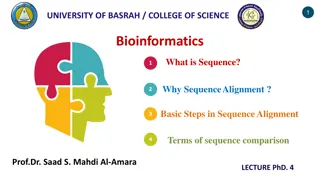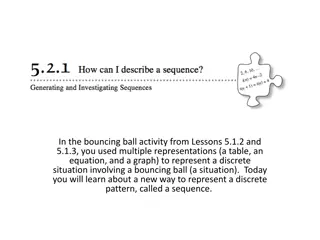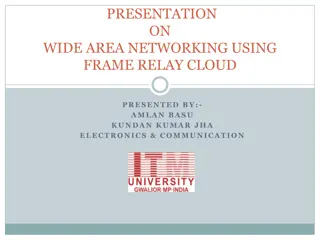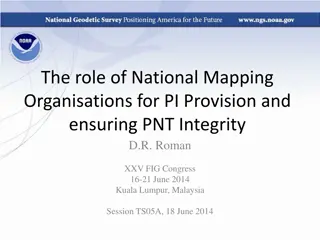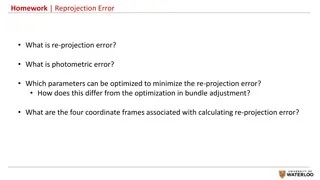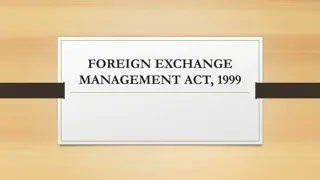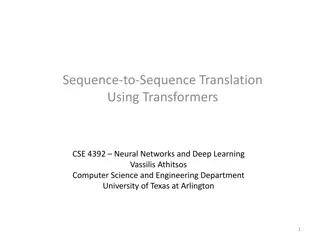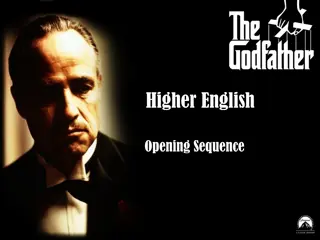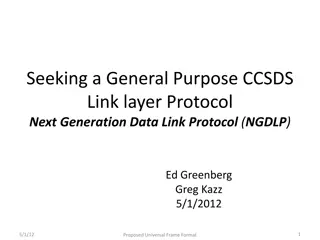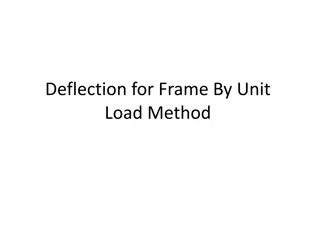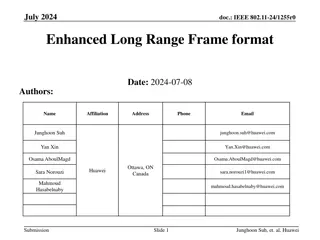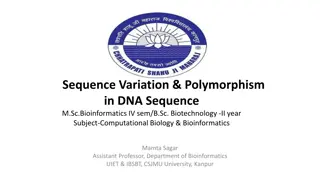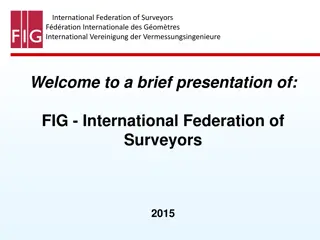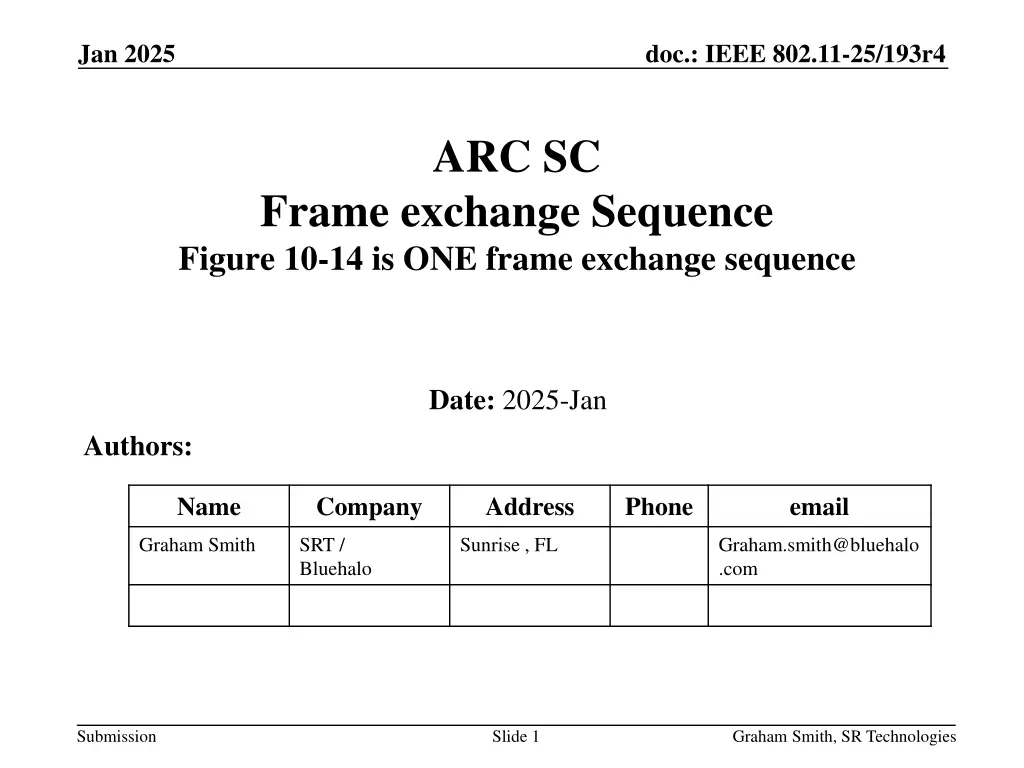
Understanding IEEE 802.11-25/193r4 Frame Exchange Sequences
Explore the definition and implications of frame exchange sequences in IEEE 802.11-25/193r4, focusing on control of the wireless medium, potential sequence variations, and adhering to transmission rules within a single sequence. The behavior of STAs within and outside a frame exchange sequence is analyzed, emphasizing compliance with transmit restrictions and post-sequence power-saving rules.
Download Presentation

Please find below an Image/Link to download the presentation.
The content on the website is provided AS IS for your information and personal use only. It may not be sold, licensed, or shared on other websites without obtaining consent from the author. If you encounter any issues during the download, it is possible that the publisher has removed the file from their server.
You are allowed to download the files provided on this website for personal or commercial use, subject to the condition that they are used lawfully. All files are the property of their respective owners.
The content on the website is provided AS IS for your information and personal use only. It may not be sold, licensed, or shared on other websites without obtaining consent from the author.
E N D
Presentation Transcript
Jan 2025 doc.: IEEE 802.11-25/193r4 ARC SC Frame exchange Sequence Figure 10-14 is ONE frame exchange sequence Date: 2025-Jan Authors: Name Company Address Phone email Graham Smith SRT / Bluehalo Sunrise , FL Graham.smith@bluehalo .com Submission Slide 1 Graham Smith, SR Technologies
Jan 2025 doc.: IEEE 802.11-25/193r4 Intro DEFINITION frame exchange sequence: A sequence of frames that maintains control of the wireless medium. Points for consideration: The definition is clear. When a frame exchange sequence is on air, all STAs know it and obey the rule not to transmit until it is complete. For example, a STA that is not part of the frame exchange sequence, but in the same network, knows that a frame exchange sequence is happening, and does not transmit during it. Rev 2 Presented Rev 4 - Added content from Slide 11. Submission Slide 2 Graham Smith, SR Technologies
Jan 2025 doc.: IEEE 802.11-25/193r4 What has been the contention? Q - Is this 1, 3, or 4 frame exchange sequences? A ONE and I will show why. See also Figures 10-43, 10-44 (Example of frame exchange sequence - NOT sequences) Submission Slide 3 Graham Smith, SR Technologies
Jan 2025 doc.: IEEE 802.11-25/193r4 The arguments for 3 or 4 frame exchange sequences have centered on STA 1 The argument is that once STA 1 has sent its BA/Ack, it could change its state, e.g., go scanning or go into power save. BUT Even if true (we will investigate this further), it must not transmit until the frame exchange sequence is complete. Submission Slide 4 Graham Smith, SR Technologies
Jan 2025 Consider STA 4, not part of the frame exchange sequence, but in the same network. doc.: IEEE 802.11-25/193r4 Must NOT transmit STA 4 STA 4 knows that a frame exchange sequence is happening AND it continues until STA 3 has transmitted. STA 4 sees just ONE frame exchange sequence. Note: STA 4 cannot inform the AP of a change of power save but could sleep (until frame exchange sequence is over). STA 1 is the same, it knows the frame exchange sequence length. Submission Slide 5 Graham Smith, SR Technologies
Jan 2025 doc.: IEEE 802.11-25/193r4 Following the definition, i.e., the transmit restriction, it is clear that this example is one frame exchange sequence. If 3 or 4, how does STA 4 behave? If 3 or 4, how does the transmit rules apply to STA 1? HOWEVER, there are rules about what a STA can do during a frame exchange sequence, and it has been suggested that STA 1 may violate such rules and hence as far as STA 1 is concerned the frame exchange sequence ends after it has transmitted. BUT it still cannot transmit So, let s now look at these frame exchange related PS rules. Submission Slide 6 Graham Smith, SR Technologies
Jan 2025 doc.: IEEE 802.11-25/193r4 Power Save and frame exchange sequence 9.2.4.1.7 Power Management subfield The Power Management subfield is used to indicate the power management mode of a STA. The subfield is either reserved (as defined below) or remains constant in each frame from a particular STA within a frame exchange sequence. The value indicates the mode of the STA after the successful completion of the frame exchange sequence. Submission Slide 7 Graham Smith, SR Technologies
Jan 2025 doc.: IEEE 802.11-25/193r4 Power Save Rules 11.2.3.1. A STA that is associated with an AP and that changes power management mode shall inform the AP of this fact using the Power Management subfield within the Frame Control field of transmitted frames. The STA shall remain in its current power management mode until it informs the AP of a power management mode change via a frame exchange sequence(#109) that includes an acknowledgment from the AP. Power management mode shall not change during any single frame exchange sequence. 11.2.3.2 To change power management modes a STA shall inform the AP by completing a successful frame exchange that is initiated by the STA. A non-AP STA shall not change power management mode using a frame exchange sequence that does not receive an Ack or BlockAck frame from the AP, or using a BlockAckReq frame. NOTE 2 The Power Management subfield is ignored in frame exchange sequences initiated by the AP. Note: There is no reason given as to why these rules exists. Presumably, it seemed a good idea at the time. Slide 8 Submission Graham Smith, SR Technologies
Jan 2025 doc.: IEEE 802.11-25/193r4 Conclusions for power save In the example Fig 10-14, 11.2.3.2 Note 2 says that STA 1 cannot tell AP that it is going into power save. Can t set PS bit in frame control. STA 1 could go into power save but AP would not know. If STA 1 set PS bit, the AP could ignore it as it should not be even checking the bit in a BA/Ack. STA 1 would have to wake after end of frame exchange sequence to send new frame exchange sequence and set PS bit. NOTES: -The rule is that the STA cannot set and transmit the PS bit in a frame exchange sequence (the PS bit is ignored), not that it can t sleep or go off and do something passive. -There is no reason given as to why these rules exists. Presumably, it seemed a good idea at the time. Submission Slide 9 Graham Smith, SR Technologies
Jan 2025 doc.: IEEE 802.11-25/193r4 Change the power save rules? If it is felt that in FIG 10-14 STA 1 should be able to sleep AND inform the AP, then a change in the specification is required. For example, the PS bit could be set in the BA/Ack BUT the AP would need to Ack it, and existing APs would not expect it. I contend that this is not practical. STA 1 could simply sleep until end of the frame exchange sequence but then would need to wake up and send packet to AP with PS bit set. Simpler to just wait? But up to the STA No text changes are proposed for power save. Submission Slide 10 Graham Smith, SR Technologies
Jan 2025 doc.: IEEE 802.11-25/193r4 Discussion - 1 Originally it was not considered that a STA was not 100% involved in a frame exchange sequence Hence, idea to specify that it can t do things was good IF some consider still that there are 3 or 4 frame exchange sequences it is, in fact, immaterial. If STA 1 is no longer taking part, there is still a frame exchange sequence in effect. HENCE STA 1 is now in the same situation as STA 4. We agree that STA 1, and STA 4 for that matter, can do stuff as long as they do not transmit Submission Slide 11 Graham Smith, SR Technologies
Jan 2025 doc.: IEEE 802.11-25/193r4 Discussion - 2 So IF we agree that STA 1, and STA 4 for that matter, can do stuff as long as they do not transmit Let s see where there is any text that may be preventing this . Submission Slide 12 Graham Smith, SR Technologies
Jan 2025 doc.: IEEE 802.11-25/193r4 MLME-SCAN 1 6.5.3.2.4 Effect of receipt This request initiates the scan process when the current frame exchange sequence is completed Note that Scan includes Active/Passive Need to be clear that active scan shall not transmit over a frame exchange sequence. Possible change to text: This request initiates the scan process when participation in the current frame exchange sequence is completed. No active scan process may be initiated on the same channel as the current frame exchange sequence until the frame exchange sequence is completed. Submission Slide 13 Graham Smith, SR Technologies
Jan 2025 doc.: IEEE 802.11-25/193r4 MLME-SCAN 2 11.1.4.1 General A STA shall operate in either a Passive Scanning mode or an Active Scanning mode depending on the current value of the ScanMode parameter of the MLME-SCAN.request primitive. NOTE 1 Active scanning is restricted in some frequency bands and regulatory domains. Could edit NOTE 1 or add NOTE 2 to cover the frame exchange sequence case. NOTE 2 - No active scan process may be initiated on the same frequency band as a current frame exchange sequence until the frame exchange sequence is completed. Submission Slide 14 Graham Smith, SR Technologies
Jan 2025 doc.: IEEE 802.11-25/193r4 MLME-JOIN 6.5.4.2.4 Effect of receipt This primitive initiates a synchronization procedure once the current frame exchange sequence is complete. The MLME synchronizes its timing with the specified BSS based on the information provided in the SelectedBSS parameter. The MLME subsequently issues an MLME-JOIN.confirm primitive that reflects the results. This is probably fine. Joining involves transmitting and won t (can t) do that while a frame exchange sequence is active. Submission Slide 15 Graham Smith, SR Technologies
Jan 2025 doc.: IEEE 802.11-25/193r4 MLME-START 6.5.11.2.4 Effect of receipt This primitive initiates the BSS initialization procedure once the current frame exchange sequence is complete. The MLME subsequently issues an MLME- START.confirm primitive that reflects the results of the creation procedure. Probably OK as is. Same argument as Join. Submission Slide 16 Graham Smith, SR Technologies
Jan 2025 doc.: IEEE 802.11-25/193r4 Aside Even if some still insist that the case of FIG 10-14 shows 3 or 4 frame exchange sequences, then these suggested additions still work. It does not really matter as AP-FES still covers the entire sequence. There is also no need, however, to describe this sequence as 3 (4?) separate sequences as this will do nothing but confuse, IMHO. The proposed clarifications cover both views. Submission Slide 17 Graham Smith, SR Technologies
Jan 2025 doc.: IEEE 802.11-25/193r4 Conclusions - 1 The frame exchange sequence definition is simple, clear and sufficient. The power save rules that have been written for frame exchange sequences (The PS bit is ignored in a frame exchange sequence), seem to be practical and keep things simple. Changing them would cause problems Figure 10-14 represents one frame exchange sequence. STA 1 must obey the basic no transmit rule until frame exchange sequence is complete. Keep it simple so ALL STAs see the same frame exchange sequence. Submission Slide 18 Graham Smith, SR Technologies
Jan 2025 doc.: IEEE 802.11-25/193r4 Conclusions - 2 The suggested additions for SCAN are probably worthwhile as they effectively cover the discussion case that STA 1 should be able to go off and do something as long as it does not transmit over the frame exchange sequence. (Some wordsmithing will inevitably take place) Submission Slide 19 Graham Smith, SR Technologies

